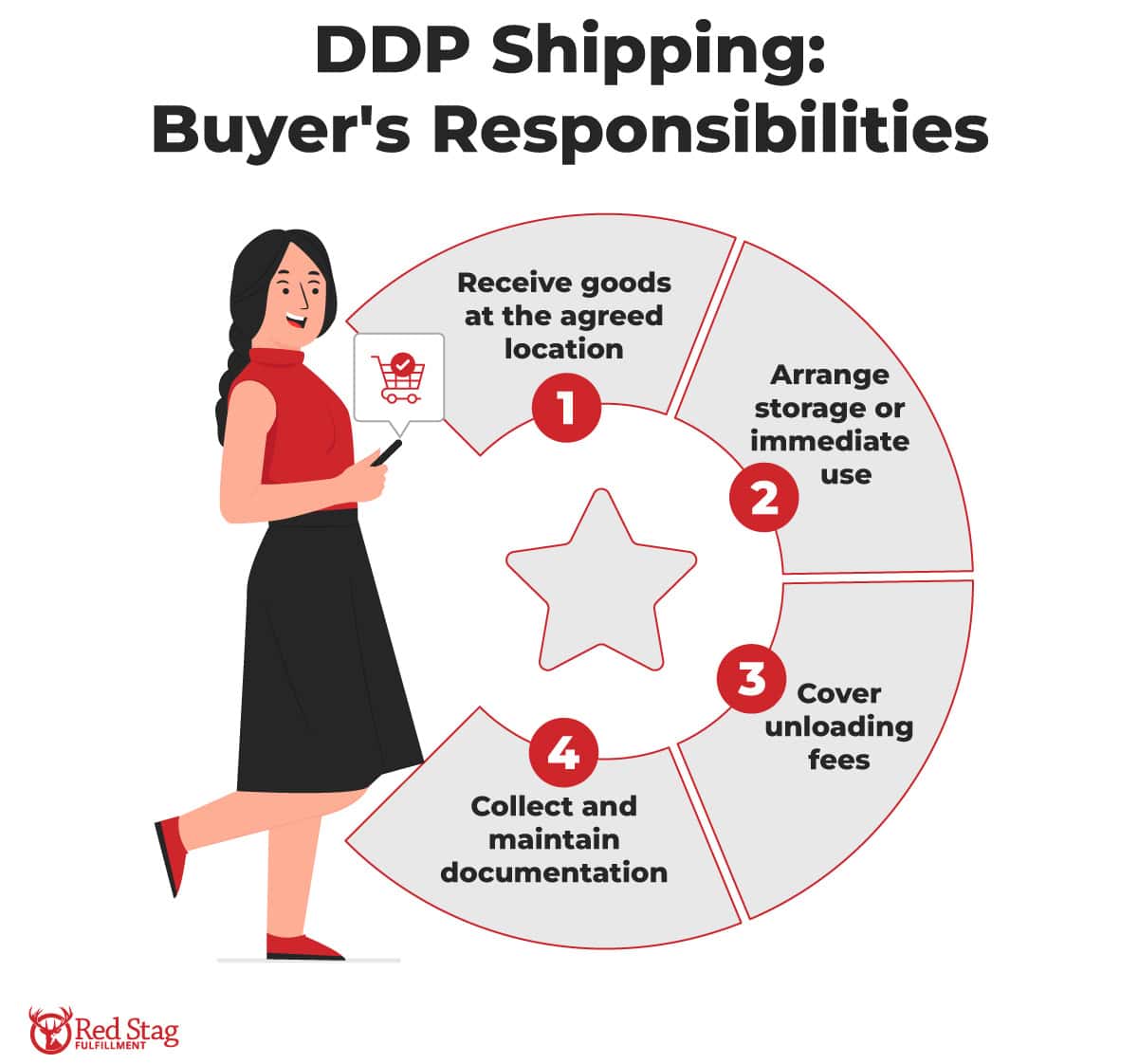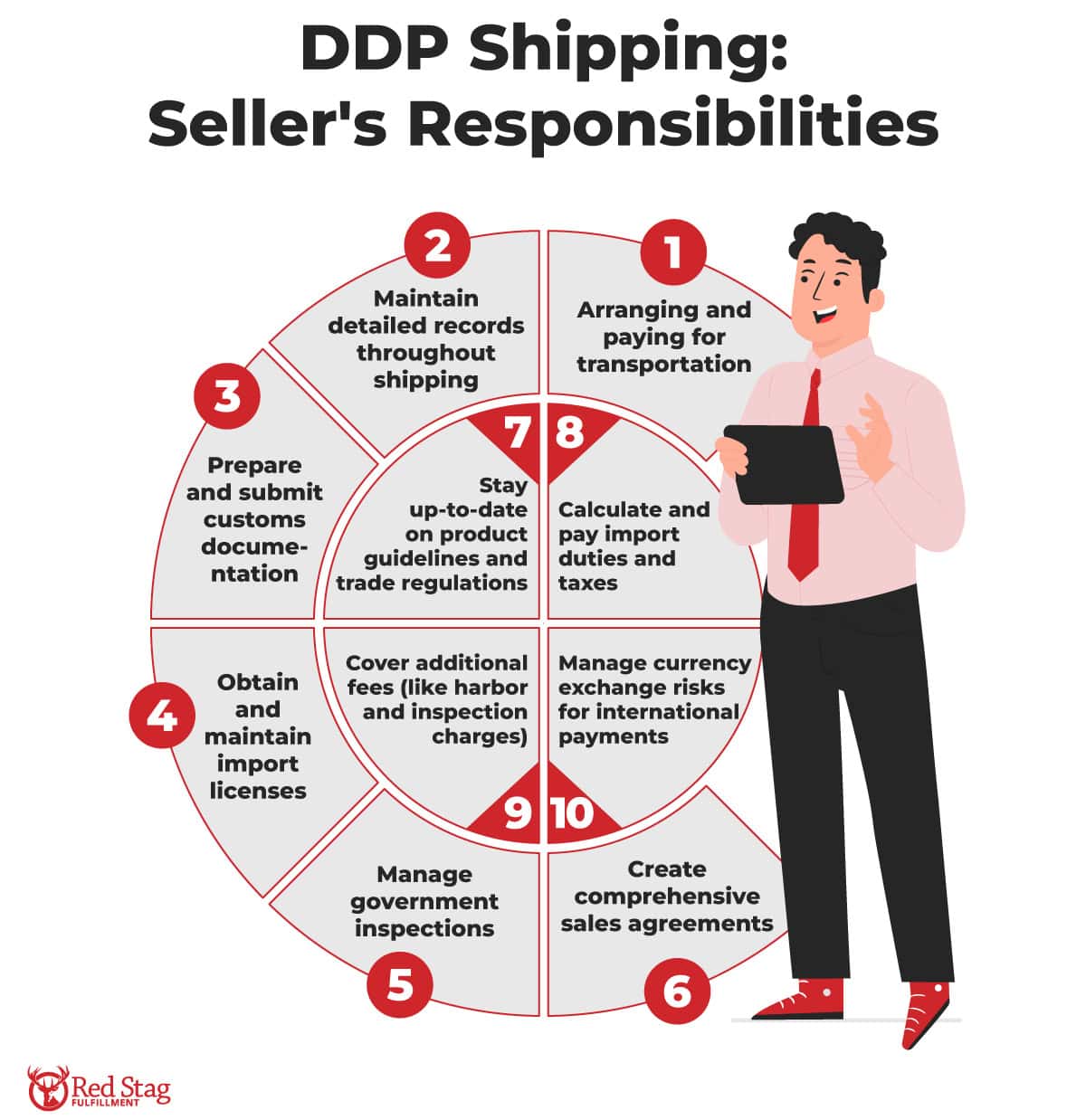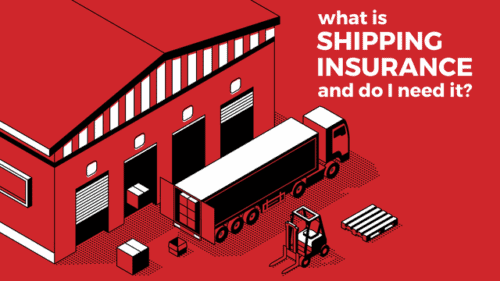Delivered Duty Paid (DDP) is a shipping method under which the seller is responsible for everything in the shipping process.
This article explains everything you need to know about DDP. We’ll discuss the advantages and drawbacks for both buyers and sellers to help you decide if this is the right solution for your business.
What is DDP (Delivered Duty Paid) shipping?

Delivered Duty Paid (DDP) shipping is a comprehensive delivery agreement in which the seller assumes all risks and costs of transporting goods, including customs and taxes, until they arrive at the buyer’s specified destination.
This arrangement is particularly popular among first-time international buyers as it simplifies the importing process by removing much of its complexity and uncertainty.
DDP shipping is part of the International Commercial Terms (Incoterms) framework. These standardized shipping options provide clear guidelines for both sellers and buyers, making international trade straightforward and predictable.
Key characteristics of DDP shipping
DDP shipping puts the seller in charge of the entire process, from origin to final destination. This includes:

Paying customs fees

Arranging transportation

Managing shipping insurance
Under DDP terms, buyers have minimal involvement. Their main role is simply receiving the goods, at which point ownership, costs, and risks transfer to them. In some cases, buyers may also need to cover unloading costs.
This simplified process is a key advantage of DDP for buyers. It eliminates hidden fees and reduces administrative work for importers.
The clear cost structure and straightforward process make DDP shipping ideal for international transactions, especially for inexperienced importers.
However, these buyer benefits create challenges for sellers. DDP arrangements require sellers to manage complex international regulations and absorb higher costs and risks. Not managing costs effectively can significantly impact profit margins.
Despite these seller challenges, DDP shipping remains attractive for international shipping thanks to its simplicity for buyers.
Considerations for buyers
DDP offers many benefits for buyers. However, before agreeing to a shipping agreement under DDP terms, buyers should carefully assess their responsibilities and potential drawbacks.

Buyer responsibilities
While sellers handle most tasks under DDP shipping, buyers still have several responsibilities:
- Receive goods at the agreed location.
Buyers must ensure someone is available to accept delivery and check the condition and quantity of items upon arrival. - Arrange storage or immediate use.
After receiving goods, buyers should perform additional quality checks to confirm the items meet standards. - Cover unloading fees.
This cost typically falls to the buyer, especially when shipping to fulfillment warehouses. Buyers need to budget for these expenses and coordinate with fulfillment centers to ensure efficient handling. - Collect and maintain documentation.
Though the seller pays shipping fees, buyers should keep records of all purchase-related documents, including taxes and import duties. This practice simplifies accounting and expense tracking.
Advantages of DDP for buyers
DDP shipping offers a range of benefits for buyers looking for a stress-free, predictable shipping solution:

Simplified importing process, including customs clearance

Reduced paperwork and administrative tasks

Predictable total costs with all-inclusive pricing

Enhanced trust when dealing with international suppliers

Less risk as the seller assumes responsibility for the shipment

Increased confidence in international transactions
By choosing DDP, the buyer can focus on core business activities while the seller handles shipping logistics. This arrangement eliminates concerns about hidden fees, simplifies budgeting, and makes cross-border purchases predictable.
Disadvantages of DDP for buyers
While DDP shipping offers a comprehensive shipping solution, it also comes with some drawbacks:

Less control over the import process and shipping methods

Higher overall costs compared to other shipping options

Limited visibility into the supply chain and tracking

Potential for slower shipping solutions

Reduced communication during shipping delays

Difficulty comparing costs with alternative shipping methods
Buyers should carefully weigh these drawbacks against the benefits, particularly when it comes to negotiating costs and surrendering control.
Considerations for sellers
Under DDP shipping terms, sellers take on significant responsibilities but gain more control over shipping. Let’s see what sellers should think about before choosing DDP.

Seller responsibilities
Sellers using DDP shipping services take on extensive responsibilities throughout the shipping process.
Transportation, logistics, and delivery
At the core of the seller’s responsibilities is arranging and paying for transportation. This involves selecting suitable carriers, negotiating rates, and coordinating pickup and delivery schedules.
Before shipping the goods, the seller must ensure they are well protected to minimize the risk of damage during transit. Adding insurance coverage can provide extra protection against potential losses.

PRO TIP: The seller must maintain detailed records throughout shipping, including proof of delivery, tracking information, and all necessary shipping documents.
Regulatory compliance and customs
Customs management is a critical aspect of DDP shipping that the seller must handle.
Sellers prepare and submit all required customs documentation to comply with export and import regulations. This includes complete commercial invoices, certificates of origin, and any product-specific paperwork.
Sellers are also responsible for obtaining and maintaining import licenses if needed. They must manage government inspections, working with authorities to address any issues quickly.
DDP terms demand a thorough understanding of international trade laws and contractual details. Sellers need to create comprehensive sales agreements that clearly outline DDP terms and conditions, ensuring all necessary legal protections are in place.

PRO TIP: Since laws are continually evolving, sellers must stay updated on product guidelines and trade regulations. Compliance also extends to anti-bribery and corruption laws, adding another layer of complexity.
Financial obligations
The financial responsibilities for sellers under DDP terms are substantial and varied.
Sellers must:

Calculate and pay import duties and taxes.

Cover additional fees like harbor and inspection charges.

Manage currency exchange risks for international payments.
It’s crucial that sellers budget carefully for these expenses and handle them efficiently, as any errors can result in financial losses that directly impact profitability.
Advantages of DDP for sellers
DDP shipping offers sellers several strategic benefits when trading internationally

Complete control over the shipping process

Potential to negotiate rates for higher profit margins

Increased customer satisfaction, trust, and conversion rates

Encouraging repeat business

Opportunity to compete in the global market
By handling shipping and import responsibilities, sellers provide a seamless experience for international customers. This approach positions them for increased profitability and broader market reach, strengthening their presence among global buyers.
Disadvantages of DDP for sellers
While DDP shipping offers numerous benefits, sellers should consider these potential drawbacks:

High shipping fees and financial risks, including unexpected fees and VAT

Complexity of navigating international regulations and customs procedures

Full liability for goods throughout the entire shipping procedure

Risk of financial losses from inaccurate pricing and cost estimation

Increased administrative workload

Potential delivery issues that may affect customer satisfaction and reputation
These challenges highlight the importance of careful planning and robust logistics management when using DDP shipping. A thorough cost analysis is crucial to determine if DDP is the right choice for your international shipping needs.
When to use DDP shipping
DDP shipping is an excellent choice for sellers in several scenarios.
- Businesses expanding into new international markets.
Using DDP in this situation allows them to test global demand and gain valuable market insights without establishing local fulfillment centers. This method is ideal for customer experience-focused brands, as it eliminates surprise fees that could sour the buyer’s experience. - Air and sea freight shipping.
It’s particularly beneficial for high-value products with an average order value above $30, as it helps offset the high costs while maintaining profitability. By choosing DDP shipping, sellers can provide a smoother international transaction process and increase customer satisfaction. - Buyers seeking a seamless, hassle-free experience.
The seller handles all paperwork and costs, making it especially beneficial for first-time purchases from an international seller. Buyers can enjoy the convenience of receiving their products without worrying about additional shipping fees or complex customs procedures.
When to avoid DDP shipping
DDP shipping isn’t suitable for everyone. Sellers new to international shipping should consider alternative methods, as DDP requires extensive knowledge of global trade regulations.
Countries with complex import procedures often present challenges that other shipping methods may address better.
The potential for unexpected costs and compliance issues can quickly eat into profits and harm customer relationships. It’s also not the best choice for low-value items with thin profit margins, as the associated expenses often exceed the potential earnings.

PRO TIP: In situations where buyers have more experience with local customs processes, it’s often better to let them handle customs clearance.
DDP vs. DDU/DAP and other Incoterms
DDP is one of many standardized terms called Incoterms (International Commercial Terms).
These terms define who’s responsible for what in international trade deals, outlining who is responsible for various aspects of the transaction, such as transportation, insurance, and customs duties.
Here’s a table comparing DDP with other common Incoterms:
| Incoterm | Description | Pros | Cons |
|---|---|---|---|
| DDP (Delivered Duty Paid) | Seller responsible for all shipping costs and risks up to buyer’s doorstep, including customs clearance, duties, and taxes | Simplest for buyer, clear total cost upfront | Highest risk and cost for seller, requires knowledge of local taxes and regulations |
| DDU (Delivered Duty Unpaid) | Seller responsible for delivery to specified location, buyer pays duties and taxes | Seller controls transport, clear division of responsibilities | Buyer must handle customs clearance, potential for unexpected costs |
| DAP (Delivered at Place) | Seller delivers to specified place, buyer handles customs, duties, and taxes | Similar to DDU but with updated terminology, clear handover point | Buyer responsible for import process, possible delays at customs |
| EXW (Ex Works) | Minimal seller responsibility, buyer assumes most costs and risks from seller’s premises | Lowest risk and effort for seller | Highest risk and effort for buyer, potential export compliance issues |
| FOB (Free on Board) | Seller responsible until goods are on board the ship, risk transfers when loaded | Well-balanced responsibilities, common in sea freight | Limited to sea transport, potential disagreements on risk transfer point |
| CIF (Cost, Insurance, Freight) | Seller arranges and pays for shipping and insurance to destination port | Seller controls shipping process, includes insurance | Buyer still handles import clearance, potential for hidden costs |
Key differences
- DDP vs. EXW:
These represent opposite ends of the responsibility spectrum. DDP puts maximum obligation on the seller, while EXW places it on the buyer. - DDP vs. FOB:
The main difference is where risk transfers. With DDP, it’s at the buyer’s doorstep. For FOB, it’s usually when goods are loaded- - DDP vs. CIF:
DDP extends the seller’s responsibility beyond the point of arrival, covering additional steps like inland transport and customs clearance. CIF ends with delivery at the arrival location. - DDP vs. DDU/DAP:
While all three involve delivery to a specified place, DDP includes duties and taxes, whereas the buyer handles these costs in DDU and DAP.
Ultimately, each Incoterm has its strengths depending on the transaction’s needs and how much responsibility each party is willing to take on.
DDP Shipping FAQ
To help you better understand DDP Shipping and how it works, we’ve compiled answers to some of the most commonly asked questions. Whether you’re new to DDP or just need clarification, these FAQs cover the essentials:

Can a buyer reject a DDP shipment on arrival?
While rare, buyers can refuse DDP shipments in certain circumstances. Valid reasons may include damaged goods, incorrect items, or missing documentation. However, the seller may lose their deposit and is responsible for the return shipping fees.










Is DDP shipping always door-to-door delivery?
DDP provides door-to-door service, but exceptions exist. Rural areas or locations with delivery restrictions may require the buyer to pick up the shipment from a local depot.










How does DDP shipping affect product pricing for international sales?
All shipping costs, duties, and taxes are included in the product prices with DDP shipping. The increased price might make products less competitive in certain markets, but it offers convenience and predictability for customers.










What happens if a DDP shipment doesn’t clear customs?
If a DDP shipment fails to clear customs, the seller is responsible for resolving the issue. This may involve providing additional documentation, paying fines, or arranging return shipping. Sellers should work closely with their customs broker to address clearance problems promptly.










Are there reasons U.S. exporters and importers should avoid using DDP?
U.S. exporters might prefer to avoid DDP when dealing with complex regulatory environments or when they lack expertise regarding import processes in the destination country.
Importers might prefer other Incoterms if they have established relationships with local customs brokers or want more control over the import process.










What are the payment terms for shipping DDP?
Payment terms for DDP shipments vary by supplier. Common arrangements include upfront payment, partial payment upon shipment, or payment upon delivery.










Who are the consignee and importer on record for a DDP shipment?
In a DDP shipment, the buyer is typically listed as the consignee. The seller, or their appointed customs broker, acts as the importer of record. They handle all customs clearance procedures and assume associated liabilities.










Does USPS offer DDP shipping?
USPS does not offer DDP shipping for international deliveries. While they provide some international shipping services, USPS cannot guarantee customs clearance or payment of import duties. Businesses requiring DDP service should consider private carriers or freight forwarders specializing in international logistics.
Outsource your logistics with a trusted partner
DDP shipping offers numerous advantages, but it’s not perfect. Buyers have to surrender control to the seller, and that means you have to trust the seller to do their job.
This isn’t just true for shipping—trusting a third party to handle critical aspects of your business is nerve-wracking no matter what.
That’s where Red Stag Fulfillment can help. We’re a 3PL with over a decade of experience managing ecommerce order fulfillment for a wide variety of businesses. We’ll handle the entirety of your order fulfillment process, and our industry experts will double as logistics consultants, helping you solve any problems that come up.
We can even help you streamline your shipping, making it easy for you to get your products from the manufacturer to our warehouses, and from our warehouses to your end customer.
Ready to hand off logistics headaches to a trusted partner? Reach out today to start a conversation.










